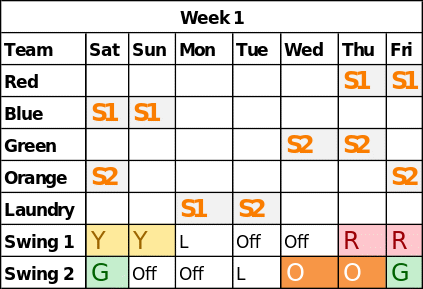Team scheduling from the point of view of guests is good as they get the luxury of housekeeping throughout the week. They receive continuous service and support from the hotel housekeeping. Such scheduling aims at providing complete satisfaction to the customers. The executive supervisors have to make a tight schedule that takes occupancy as the key for scheduling and providing maximum customer satisfaction. From the point of view of employees, this type of scheduling implies that they have to work seven days a week when occupancy is full and at low occupancy, they may get two days off. Thus, when occupancy is low, the scheduling allows for extra days off. The staff scheduling is based on the system of rotational schedule based on the occupancy of the hotel (Jones 45). This system allows for only 40 hours a week for the employees with two days off every week. Further, in certain two weeks in a seven-week schedule, employees get more than two days off consecutively and therefore becomes one of the best selling points for the system.
Team staffing will work for all departments wherein the workweek starts from a fixed workday, say Saturday, and ends on a Friday. Workers will work only 5 days a week and the extra work they do will draw overtime pay. Therefore, the workers are happy as they get extra pay for extra work. However, the departments, which are not based on wages and overtime payment, will not be able to implement this. This type of scheduling is possible for the employees in the Front Desks and customer care cell of the hotel call center departments.
How does the work calendar work in this type of scheduling? In this case, the work calendar is divided into seven distinct days, starting from Saturday through Friday. In a full occupancy situation, each team will be assigned two full days off. Every week the days, which are assigned as off days, will rotate forward by one day. So if it was Friday and Saturday for team Red in the first week, it will be Saturday and Sunday the next week. This work rotation of the off days will carry forward for seven weeks and on the eighth week, the schedule will fall back and become identical with the week 1 schedule.

From the schedule thus formed (see figure 1), it is observed that a worker/team based on this form of scheduling may have more than two days off in a week. The day when a worker has more than 2 days off is underlined in figure 1. The colored slots are the days off. It must be noted that as the weeks move ahead, the colored box moves to the next succeeding day. In the second week, the days off are split on the opposite ends of the week which according joins with the days off with the weeks previous and after this week. In the case of figure 1, the split days off is on week 2, where the days off are joined with that of week 1 and week 3. These results in two weeks were the teams get three consecutive days’ leave. Therefore, a team or a worker may get two more than two consecutive days’ leave in a span of 7 workweeks. Thus, when the employees have an off on the weekend, they will enjoy three consecutive days’ leave.
Figure 2 presents the schedule for week 1 of the teams. There are four teams red, blue, green, and orange, the laundry team, and two swing teams. The table shows the days that are off for the teams, and the blocks, which are empty, signifies working days for the teams. However, for the swing teams, it is necessary to specify for which team they are replacing workers to let them know exactly where they are expected to work. In this system, the members of the team are expected to work if the team block is left empty. On Thursday and Friday, the Red (R) teams have off and in their place swing team, one (S1) is working. Now that the R team had it’s off, the team must be kept working for the rest of the next five days. Now that S1 has relieved team Red and Yellow, and the laundry team it is expected to take off on Tuesday and Wednesday. This process is followed to make the schedule for week 1. Now the schedule for the next four weeks is made by advancing the days of the leaves by 1 day following the system mentioned in figure 1 and therefore making the rest of the workweek schedules.

This schedule assumes 100% occupancy. In case of less than 100% occupancy, teams can be reduced in size and have more scheduled workdays for the employees. However, if the staffing is inadequately equipped to service the occupancy, then employees who are off may be offered overtime to fill in the gaps.
The problem that may arise out of the schedule is that the unions will be skeptical about the team’s scheduling is that if an individual employee does not arise due to some ailment, how will the team perform, for in case of tight scheduling there is optimum utilization of time. Further, there are no arrangements for sick leaves available for the teams or their members. Further, the supervisor must keep a record of the scheduling in order to have a complete record of the fairness of the scheduling process.
Works Cited
Jones, Thomas J. A. Professional Management of Housekeeping Operations. New Jersey: John Wiley and Sons, 2008.